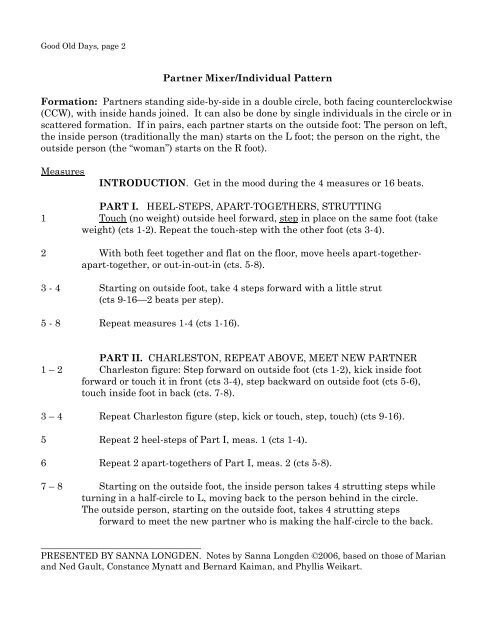no child left on his or her behind - Indiana Music Education ...
no child left on his or her behind - Indiana Music Education ... no child left on his or her behind - Indiana Music Education ...
Good Old Days, page 2 Partner Mixer/Individual Pattern Formation: Partners standing side-by-side in a double circle, both facing counterclockwise (CCW), with inside hands joined. It can also be done by single individuals in the circle or in scattered formation. If in pairs, each partner starts on the outside foot: The person on
THE GRAND MARCH (Processional from many countries as well as U.S. Eastern-seaboard Colonial Almost every ball in the late 18 th century began with a Grand March, as well as dance parties in many European countries. It helps to have a leader near the music to direct the dancers. This dance is taught on Sanna’s DVD/video#5, Historic & Contemporary Dances for Kids & Teachers. Music: On Sanna’s CD#2 (―Sweet Richard,‖ a Colonial tune played on period instruments from ―American Country Dances of the Revolutionary Era, 1775-1795," by The Hendrickson Group, used with permission). Other marches are also useful. To start: Traditionally, the Grand March began with couples forming a long column behind a lead pair. Other ways to begin: Men line up along one side, women along the other, facing down the hall. The first two in each line walk toward each other and proceed up the hall side-by-side as everyone follows, joining up with someone from the other side. Or start everyone in one straight line facing the music, then continued to alternate to right and
- Page 1 and 2: NO CHILD LEFT ON HIS OR HER BEHIND:
- Page 3 and 4: ALOHA KAKAHIAKA (Hawai'i) "Good mor
- Page 5 and 6: DEBKY (Arabic) The debky is one of
- Page 7: GOOD OLD DAYS (U.S.A) This type of
- Page 11 and 12: Or finish it as a PARTNER DANCE (If
- Page 13 and 14: HIGHLIFE or PANDOGA (Ghana, West Af
- Page 15 and 16: HOE ANA (Rarotonga Islands/Tahiti)
- Page 17 and 18: HOW DO YOU DOO-TEE (Australia) This
- Page 19 and 20: I LOVE A RAINY NIGHT (Double-line U
- Page 21 and 22: THE PADDY O’FURNITURE JIG (sort o
- Page 23 and 24: SASHA (Russia—Germany) ―Sasha
- Page 25 and 26: Swing dancing, page 2 (b) Do <stron
- Page 27 and 28: Tokyo Dontaku, page 2 PART III. Mak
- Page 29 and 30: YAN or JEAN PETIT (Southern France)
- Page 31 and 32: Grade 3 Introduction TT5sON AT A GT
- Page 33 and 34: ,) ' E'##:Ji [: i:, ;:::1,:: 3 t#;:
Good Old Days, page 2<br />
Partner Mixer/Individual Pattern<br />
F<strong>or</strong>mati<strong>on</strong>: Partners standing side-by-side in a double circle, both facing counterclockwise<br />
(CCW), with inside hands joined. It can also be d<strong>on</strong>e by single individuals in the circle <strong>or</strong> in<br />
scattered f<strong>or</strong>mati<strong>on</strong>. If in pairs, each partner starts <strong>on</strong> the outside foot: The pers<strong>on</strong> <strong>on</strong> <str<strong>on</strong>g>left</str<strong>on</strong>g>,<br />
the inside pers<strong>on</strong> (traditi<strong>on</strong>ally the man) starts <strong>on</strong> the L foot; the pers<strong>on</strong> <strong>on</strong> the right, the<br />
outside pers<strong>on</strong> (the ―woman‖) starts <strong>on</strong> the R foot).<br />
Measures<br />
INTRODUCTION. Get in the mood during the 4 measures <strong>or</strong> 16 beats.<br />
PART I. HEEL-STEPS, APART-TOGETHERS, STRUTTING<br />
1 Touch (<str<strong>on</strong>g>no</str<strong>on</strong>g> weight) outside heel f<strong>or</strong>ward, step in place <strong>on</strong> the same foot (take<br />
weight) (cts 1-2). Repeat the touch-step with the ot<strong>her</strong> foot (cts 3-4).<br />
2 With both feet toget<strong>her</strong> and flat <strong>on</strong> the flo<strong>or</strong>, move heels apart-toget<strong>her</strong>apart-toget<strong>her</strong>,<br />
<strong>or</strong> out-in-out-in (cts. 5-8).<br />
3 - 4 Starting <strong>on</strong> outside foot, take 4 steps f<strong>or</strong>ward with a little strut<br />
(cts 9-16—2 beats per step).<br />
5 - 8 Repeat measures 1-4 (cts 1-16).<br />
PART II. CHARLESTON, REPEAT ABOVE, MEET NEW PARTNER<br />
1 – 2 Charlest<strong>on</strong> figure: Step f<strong>or</strong>ward <strong>on</strong> outside foot (cts 1-2), kick inside foot<br />
f<strong>or</strong>ward <strong>or</strong> touch it in fr<strong>on</strong>t (cts 3-4), step backward <strong>on</strong> outside foot (cts 5-6),<br />
touch inside foot in back (cts. 7-8).<br />
3 – 4 Repeat Charlest<strong>on</strong> figure (step, kick <strong>or</strong> touch, step, touch) (cts 9-16).<br />
5 Repeat 2 heel-steps of Part I, meas. 1 (cts 1-4).<br />
6 Repeat 2 apart-toget<strong>her</strong>s of Part I, meas. 2 (cts 5-8).<br />
7 – 8 Starting <strong>on</strong> the outside foot, the inside pers<strong>on</strong> takes 4 strutting steps while<br />
turning in a half-circle to L, moving back to the pers<strong>on</strong> <strong>behind</strong> in the circle.<br />
The outside pers<strong>on</strong>, starting <strong>on</strong> the outside foot, takes 4 strutting steps<br />
f<strong>or</strong>ward to meet the new partner who is making the half-circle to the back.<br />
_________________________________<br />
PRESENTED BY SANNA LONGDEN. Notes by Sanna L<strong>on</strong>gden ©2006, based <strong>on</strong> those of Marian<br />
and Ned Gault, C<strong>on</strong>stance Mynatt and Bernard Kaiman, and Phyllis Weikart.



